Organic Voice Disorders
Structural Disorders
Contact Ulcers
The Lesion and Effect on Vibration
A contact ulcer is a sore on the mucosal tissue of the posterior part of the larynx, usually on the arytenoid cartilage or very posterior portion of the vocal fold. It appears similar to a canker sore in the mouth. A contact ulcer can be quite painful. Contact ulcers are very similar in cause, effect, and treatment to granulomas.
Cysts
The Lesion and effects on vibration
A cyst is a growth that forms beneath the surface layer of the vocal fold mucosa. It causes a gap between the two vocal folds and prevents normal vibration. Or it may cause some portion of the vocal fold mucosa to become stiff, which also prevents normal vibration, affecting the voice quality and ease of vocal production.
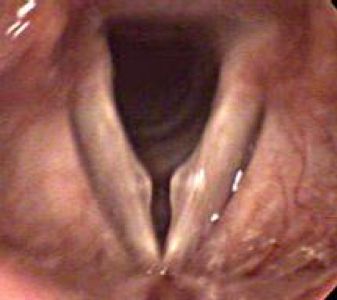
Sound of Voice
The voice may have a range of sound from normal to breathy to very rough and hoarse.
Complaints
- May include:
- abnormal voice quality
- vocal fatigue
- discomfort after extensive talking
Cause
The exact cause of any cyst is usually unknown. It often can occur with minute bleeding (hemorrhage) in the mucosa of the vocal fold. The bleeding resolves, but leaves a tiny bit of scar tissue, and the cyst forms around it. The cyst may be solid, filled with fluid, or even filled with blood. The initial bleed may be caused by a relatively short period of intense vocal fold vibration, such as severe coughing or screaming. However this is not always the case. Contributing factors may include taking medication to reduce platelet function (aspirin and non-steroidal anti-inflammatory drugs). Cysts are typically found on one vocal fold, but can be found on both. It is also common for a nodule to form on the opposite vocal fold in response to the additional pressure from the cyst.
Treatment
Cysts may resolve by simply reducing vocal fold impact for a time. However, they often require surgical removal. Pre- and post-surgical functional voice therapy usually improves the surgical result.
Granuloma
The Lesion and Effects on Vibration
A granuloma is a benign growth that typically occurs in the posterior (back) part of the larynx, either directly on the vocal fold, or on one of the mucosal surfaces nearby. The growth may prevent glottic closure, causing vibration to be weak or non-existent. This could cause a weak or breathy voice, or frequent "breaks" in the voice. Or the lesion may interfere with vibration, causing a rough, irregular sound. The voice may fatigue easily and become worse sounding with continued use. A lesion that is not directly on the vocal fold may not interfere with voice quality, but can be very irritating and even painful. A large enough lesion may obstruct the airway.
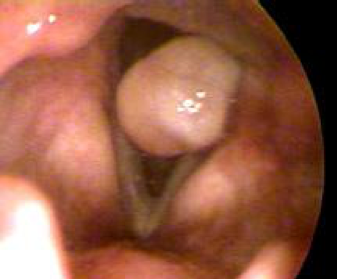
Sound of Voice
Ranges from normal to breathy to extremely rough and hoarse. Often worsens with increased voice use.
Complaints
May include:
- abnormal voice quality
- vocal fatigue
- discomfort or pain associated with increased talking
- interference with breathing
- a sense of something irritating in the throat that needs to be cleared or coughed away
Cause
The granuloma is actually one of the body's ways of healing or protecting itself from an inflammatory or infectious process. It is believed to be related to an infectious process within the cartilage of the larynx. Granulomas can occur in a number of ways, but most are related to some acute or chronic injury, such as:
- trauma from intubation during surgery
- an extended bout of coughing or other vocal trauma
- chronic reflux (see our section on LPRD)
- chronic mild trauma such as frequent throat-clearing
Granulomas may occur from any single or combination of the above, but it is often difficult to determine an exact cause.
Whatever the initial cause, vocal fold trauma or impact will usually make the granuloma worse. Loud or excessive talking, throat-clearing, coughing, grunting, and effortful vocal production can all cause the granuloma to grow larger.
Treatment
Treatment for granuloma can be frustrating, as the lesion can be quite tenacious. Many surgeons prefer to remove the lesion immediately, but recurrence is common. At the Lions Voice Clinic, the first line of treatment for granulomas is medical and functional:
- Anti-reflux medications are prescribed to eliminate any burning from acid reflux. Also, the patient is counseled about dietary, lifestyle, and mechanical precautions to alleviate GERD/LPRD.
- A short course of steroids may be prescribed to reduce the inflammation and, hopefully, the size of the granuloma.
- Antibiotics may be given to alleviate any infectious process.
- Speech therapy is initiated to help identify sources of high vocal fold impact, and to teach techniques to reduce the impact while talking.
The above treatment may be enough to cause the granuloma to resolve. However, sometimes surgery is required to remove the lesion.
Surgery
Medical and functional therapy may be enough to cause the granuloma to resolve. However, sometimes surgery is required to remove the lesion.
Some things you should know about surgery:
- It is done under general anesthesia.
- The area is often injected with steroids immediately after removal of granuloma.
- Total voice rest is prescribed for 3-5 days after surgery.
- Voice use is minimal at first, with a very gradual return to complete voice use (1-4 months, depending on the surgical wound and the extent and type of voice use required).
- Functional treatment is continued, voice use is monitored, and medical treatment may be used again.
Granulomas are known for recurring, which can be frustrating to the patient, and patients frequently come to the Lions Voice Clinic after multiple surgeries. These patients are usually frustrated and looking for another answer. However, they're often surprised to hear that another surgery may just aggravate an already inflamed area, and that speech therapy is an important part of the treatment process. Fortunately, this treatment program turns out to be successful in the vast majority of cases.
Hemorrhage
The Lesion and Effects on Vibration
A hemorrhage occurs when a tiny blood vessel within the vocal fold bursts, creating a bleed into the mucosal covering. The accumulation of blood under the surface of the vocal fold makes the fold stiff, which makes vibration more difficult. The amount of the bleed can vary greatly, and so can the effect on the voice, but often it is large enough to prevent vibration of the affected vocal fold altogether. Small hemorrhages may cause only slight changes in voice quality, which could go unnoticed by someone using their voice actively.
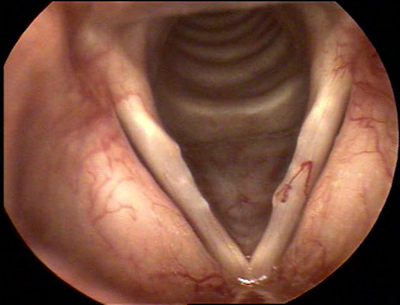
Figure A: Small Hemorrhage
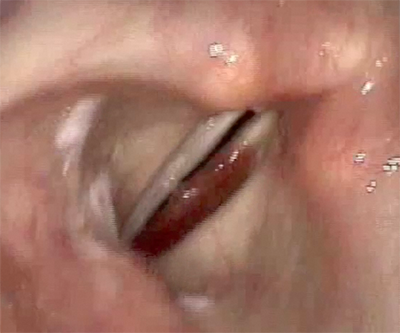
Figure B: Extensive Hemorrhage
Sound of Voice
A hemorrhage is typically an acute (sudden) event, and the voice may suddenly "cut out" or become very weak, breathy, or rough. A person experiencing a hemorrhage may suddenly find themselves unable to produce a sound. This resolves over time as the blood accumulation subsides.
Complaints
May include:
- sudden decrease in voice quality
- loss of pitch range
- loss of volume
- loss of vocal control
Cause
A hemorrhage occurs when there is sudden high impact, or prolonged impact to the vocal folds, and is more likely to occur when the blood vessels in general are already more susceptible to hemorrhage. This may happen when some anticoagulant, such as aspirin products, or some vasodilator, such as alcohol products, are used. It is also more common in women during their menstrual period. Therefore, we caution women suffering from menstrual cramps not to take aspirin, have a drink, then go out on stage and scream!
Treatment
It is possible that a small hemorrhage will have resolved to a large extent before it is even diagnosed, in which case reduced and careful voice use should allow for complete resolution. A person with a very recent and substantial hemorrhage is advised to undergo several days of total voice rest. This is one of the few times when we advise no voice use at all. After a maximum 5 days of silence, there should be enough resolution of the hemorrhage to resume voice use gradually. The extent of vocal decrement can vary greatly, as can the demands of the voice user. Professional voice users with a hemorrhage are generally advised to undergo some voice therapy and/or monitoring during the first month or two following the incident, in order to prevent further damage. This is why it is important to be seen very soon after any sudden decline or loss of voice.
Sometimes the bleed becomes encapsulated into a cyst or polyp. This may still resolve on its own, but the likelihood is greater that it will have to be surgically removed. At the Lions Voice Clinic, we prefer to try several months of intensive voice therapy before resorting to surgical removal. In therapy, techniques are taught that will promote safe voice use for the postoperative period, should surgery be necessary.
Hyperkeratosis
The Lesion and Effects on Vibration
These lesions can vary in size, location, and how deeply they have grown into the vocal fold tissue, which affects the stiffness of the mucosal tissue. Therefore, their effects on vibration can be highly variable.
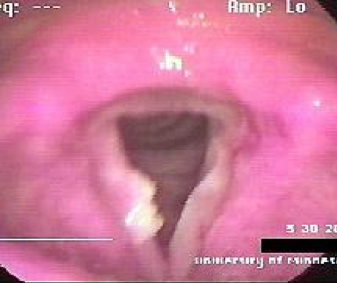
Sound of Voice
The voice may have a range of sound from normal to breathy to very rough and hoarse.
Complaints
May include:
- abnormal voice quality
- vocal fatigue
- discomfort after extensive talking
Cause
The exact cause is too complex for this website, but it's helpful to think of this as like a scab that the skin forms as it heals from a wound or protects itself from an irritant. In this case the "scab" is on the vocal fold.
Treatment
Careful monitoring is the most important aspect of treatment for this kind of lesion, as it looks similar to cancer, and therefore will warrant a biopsy if it does not improve with reduced vocal fold impact and improved environment (e.g. smoking cessation and greatly improved hydration).
Laryngitis
The Lesion and Effects on Vibration
The term laryngitis simply means an inflammation of the larynx, usually in response to an upper respiratory infection, or some other irritant, such as “reflux laryngitis.” The vocal folds become swollen, inflamed, and stiff, resulting in poor, irregular vibration.
Sound of Voice
We often refer to “laryngitis” as a voice quality, rather than a condition of the larynx. The distinct quality is well-known: the sound of someone who is hoarse from an upper respiratory infection (a “cold”). The quality can vary from slightly husky and low-pitched to hoarse to nearly a whisper.
Complaints
May include:
- abnormal voice quality
- limited pitch and volume
- vocal fatigue
- discomfort after extensive talking
Cause
Laryngitis can be an acute condition from upper respiratory infection or recent high-impact vocal fold vibration (such as screaming at a sporting event) to more chronic, such as reflux laryngitis.
Treatment
Because laryngitis is often acute and resolves when the upper respiratory infection resolves, medical treatment is often not necessary. An exception to this is when a performer has laryngitis and needs fast voice improvement in order to perform. In that case, it is helpful to be seen by a voice specialty team like the Lions Voice Clinic to help determine if medical intervention like a course of steroids is appropriate. Please see our comments on Medicating Edematous Vocal Folds in the You and Your Voice section for further discussion of the use of steroids to treat acute laryngitis.
Leukoplakia
The Lesion and Effects on Vibration
These lesions can vary in size, location, and how deeply they have grown into the vocal fold tissue, which affects the stiffness of the mucosal tissue. Therefore, their effects on vibration can be highly variable. These lesions represent changes to the lining of the vocal fold edges that are precancerous.
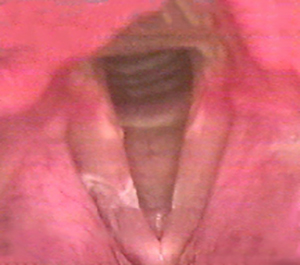
Sound of Voice
The voice may have a range of sound from normal to breathy to very rough and hoarse.
Complaints
May include:
- abnormal voice quality
- vocal fatigue
- discomfort after extensive talking
Cause
The exact cause is too complex for this website, but it's helpful to think of this as like a scab that the skin forms as it heals from a wound or protects itself from an irritant. In this case the "scab" is on the vocal fold.
Treatment
Careful monitoring is the most important aspect of treatment for this kind of lesion, as it looks similar to cancer, and therefore will warrant a biopsy if it does not improve with reduced vocal fold impact and improved environment (e.g. smoking cessation and greatly improved hydration).
Nodules (a.k.a. "Singers’ Nodes")
The Lesion and Effects on Vibration
Nodules are callous-like swellings that form just below the epithelial surface of the vocal folds. They occur on both vocal folds and are symmetrical. The nodules appear as small bumps along the mid portion of the vocal folds, where the vocal folds come into contact with each other. The nodules may create a gap between the two vocal folds allowing air to escape and prevent normal vibration. They may also stiffen the mucosal tissue, causing irregular vibration and a rougher sound.
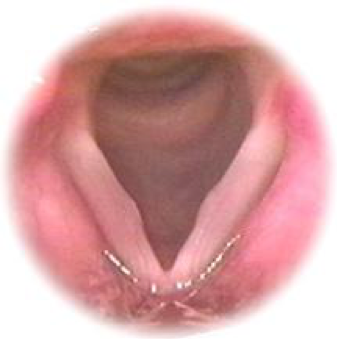
Sound of Voice
May range from normal to breathy to very hoarse and strained. The inability to sing high, soft notes is one of the hallmarks of nodules. When the individual tries to sing high and soft, there is a delay in the onset of the sound, with an audible air escape, and then the sound starts abruptly.
Complaints
May include:
- abnormal voice quality
- limited pitch and volume
- vocal fatigue
- discomfort after extensive voice use
Cause
Nodules typically occur in people who use their voice in an intense manner over an extended period of time. The nodules appear as small bumps along the mid portion of the vocal folds, and are a result of the thickening of the surface layer of the vocal folds. The nodules are a natural response to increased trauma, similar to calluses on the hands.
Treatment
When the trauma is reduced, often through learning improved techniques in functional voice therapy, the nodules nearly always resolve. Surgery is rarely needed and is usually contraindicated if the individual has not learned to reduce the trauma. This would likely cause the nodules to recur.
Papilloma
The Lesion and Effects on Vibration
Laryngeal papilloma, also known as Recurrent Respiratory Papillomatosis, are benign lesions that grow in the respiratory tract. They are benign lesions. Very rarely these undergo malignant transformation. These are known to recur and need frequent treatment.
These lesions can vary in size, location, and how deeply they have grown into the vocal fold tissue, which affects the stiffness of the mucosal tissue. Therefore, their effects on vibration can be highly variable.
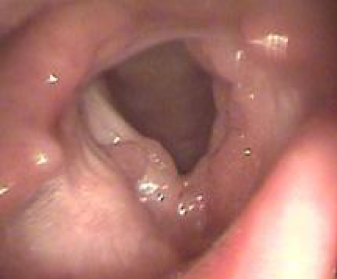
Sound of Voice
The voice may have a range of sound from normal to breathy to very rough and hoarse.
Complaints
May include:
- abnormal voice quality
- vocal fatigue
- discomfort after extensive talking
Cause
Recurrent Respiratory Papillomatosis (RRP) can occur in very early childhood, or can come on in adulthood. Although it is related to the Human Papilloma Virus, the cause for each individual is unclear. It is not related to sexual activity.
Treatment
In years past, it was necessary to go to the operating room (OR) whenever the papilloma had grown large enough to make the voice bad enough to warrant a general anesthesia. This could happen every couple of years for some patients, but every couple of months for others. Now, after an initial surgery or two in the OR, many patients are able to have small amounts of papilloma removed with the KTP laser in an in-clinic procedure, saving a great deal of time, money, and inconvenience. Functional therapy is often helpful, to teach the individual techniques and strategies for optimizing their voice in the presence of disease, and compensating with as little effort as possible.
Polyps
The Lesion and Effect on Vibration
Polyps are similar to cysts in that they are growths arising from the vocal fold mucosa. They may be solid or fluid filled, and can become quite large. Their effects on vibration depend on their size and their location on the vocal folds.
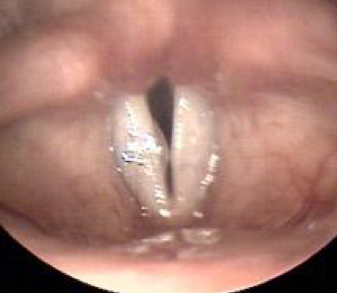
Sound of Voice
May vary from normal to severely dysphonic (very poor voice quality).
Complaints
May include:
- abnormal voice quality
- vocal fatigue
- discomfort after extensive talking
- a sense of something irritating in the throat that needs to be cleared or coughed away
- problems with breathing, if the polyp is very large
Cause
Like cysts, polyps may result from some sort of trauma or impact to the vocal folds, or arise for some unknown reason. Although polyps tend to be more associated with sudden, acute trauma, smokers' polyps are a reaction of the vocal fold mucosa to the chronic insult of smoking. They cause the well-known "smoker's voice."
Treatment
Like cysts, polyps may resolve on their own with improved vocal hygiene, but are more likely to require surgical removal. At the Lions Voice Clinic, surgical removal of polyps is done after a course of functional voice therapy to optimize surgical results. Smoker's polyps are not likely to be removed unless the individual stops smoking, because continued smoking increases the chance that the polyps will return.
Trauma
Accidents can cause a variety of fractures, lacerations, and other injuries to the larynx. These injuries and their effects on the voice vary widely, as does treatment. Fortunately, many severe injuries can be treated well with surgery and therapy, and a normal or near-normal voice may often result.
Miscellaneous Growths
There are a number of other kinds of growths that can occur within the larynx. Most are non-life-threatening, and their impact on voice quality can vary greatly. Luckily, most growths can be treated medically or surgically.
Neurological Disorders
Paralysis/Paresis
The Disorder and Its Effects on Vibration
One or both vocal folds do not move, often causing a gap between the two vocal folds, which allows air to leak through and disrupts vibration. Typically, there is some nerve regrowth into the paralyzed vocal fold but movement may or may not return if the nerve regrowth is random. If the damage is permanent and there is no movement at all to the vocal fold, it is considered a paralysis. If there is some movement but movement is reduced, it is called a paresis, which means "weakness."

Sound of the Voice
May be weak, breathy, rough, diplophonic (two pitches occurring at the same time), or just a whisper.
Complaints
May include:
- Lack of volume
- Lack of vocal strength
- Vocal fatigue, which increases with voice use
- Poor voice quality
- Shortness of breath; running out of breath while talking
- Swallowing problems
Cause
Damage to one of the two nerves that go from the brain to the larynx, most commonly the recurrent laryngeal nerve (see Anatomy: The Role of the Nervous System, in our About the Voice page.) Vocal fold paralysis can result from surgeries such as anterior cervical fusion, and thyroid, cardiac, and pulmonary surgeries. It is also possible for a virus to cause damage to the nerve, often with few, or no, other symptoms of the virus.
Treatment
In people with mild voice impairment and moderate vocal demands, functional voice therapy is often effective. However, multiple surgical options are also available to people who do not obtain a satisfactory result with speech therapy.
The principal goal of surgical treatment for paralysis is to move the vocal fold into a position so that it can effectively be used by the mobile vocal fold on the other side to produce vibration.
Injections: Injections work by bulking up the vocal fold, which moves it closer to the midline. This allows the mobile vocal fold to vibrate against the immobile fold. The material that is injected eventually resorbs, some materials take a few months and some take up to 2 years. In unique circumstances fat augmentation can also be offered. Depending on what the goal is your doctor will choose the appropriate injectable for your. Most injections done at the Lions Voice Clinic are done with local anesthesia to the larynx in clinic. This unique approach allows for immediate feedback on voice and breathing results. In certain cases, the injections are done in the operating room as outpatient surgery.
Implants: A permanent material is placed into the immobile vocal fold to bulk it up, to allow the two vocal folds to vibrate against each other. The procedure is performed in the operating room with mild sedation to allow for biofeedback on voice improvement to tailor the implant to precisely what is needed. There are multiple materials that can be implanted, all of which can produce good results. Another option for an immobile vocal fold is a procedure called a thyroplasty. In a thyroplasty, a solid piece of material is placed through a window made in the cartilage of the larynx (the side of the “Adam’s Apple”). The larynx is reached through a small incision in the neck. The material is inserted through the window, and placed in the immobile vocal fold to move it toward the middle. The procedure is performed in the operating room with mild sedation so that the voice can be tested and the implant modified as needed. There are multiple materials that can be implanted, all of which can produce good results.
Reinnervation: A third option for unilateral vocal fold immobility due to nerve dysfunction is reinnervation. In this procedure, a nerve is "borrowed" from one of the neck muscles and "hooked into" the recurrent laryngeal nerve. A disadvantage is that 6 to 12 months are needed for the nerve to start functioning to provide substantial voice improvement. Because of this, a vocal fold injection is often used to temporarily move the vocal fold to the middle. Following a reinnervation, the vocal fold will not actually move, but will have excellent position, bulk and muscle tone so that it can meet the other vocal fold at the midline.
Spasmodic Dysphonia (SD)
a.k.a. Laryngeal Dystonia (LD)
The Disorder and Effects on Vibration
Spasmodic Dysphonia (SD) is the common name for Laryngeal Dystonia. Dystonia is a family of neurological movement disorders, caused by a problem in the nervous system. Dystonias can affect many parts of the body, and when a dystonia affects the larynx, it is called Laryngeal Dystonia or Spasmodic Dysphonia. The vocal folds vibrate normally, but they spasm intermittently during speech.
There are two kinds of laryngeal spasms, creating three kinds of Spasmodic Dysphonia.
Adductor Spasmodic Dysphonia
This is the most common type of SD. The thyroarytenoid muscle (the muscle that lies within each vocal fold) contracts strongly and suddenly as in a muscle spasm. This causes the vocal folds to suddenly squeeze together very tightly. The result is a sudden breaking, stopping, or strangling of the voice.
Abductor Spasmodic Dysphonia
This less common form of SD causes the posterior cricoarytenoid muscle (the muscle that draws the vocal folds apart) to contract suddenly, causing the vocal folds to pull apart suddenly. The result is a sudden "blowing out" or breathiness of the voice.
Mixed Spasmodic Dysphonia
This is the most rare form of SD, in which both adductor and abductor spasms are present during speech.
Sound of voice
Adductor SD: the voice sounds tense, tight, strained, strangled, with sudden stoppages of the voice.
Abductor SD: the voice sounds breathy, weak, leaky, with sudden blowouts
Complaints
May include:
- Poor voice quality, may be so severe that speech is unintelligible
- Loss of control of the voice
- Fatigue, strain, and effort associated with voice use
Cause
Though we know that Spasmodic Dysphonia is a neurologic disorder, the exact cause is unknown; for more discussion, we recommend the web sites of the National Spasmodic Dysphonia Association or the Dystonia Medical Research Foundation.
Treatment
There is no cure for SD. However, treatment using Botox injections is often very helpful, especially for Adductor SD. Botox is the nickname for Botulinum Toxin, which is a strain of botulism, a powerful poison. When small amounts of Botox are injected into the vocal folds, the muscle is weakened, and the spasms are reduced or eliminated. The injections cause weakness or breathiness to the voice for the first few weeks, but then the voice strengthens and is without spasms for an average of three months. The spasms gradually return, and more Botox must be injected.
In the case of abductor SD, the Botox is injected into the posterior cricoarytenoid muscle (the abductor muscle) to reduce abductor spasms.
For more information about Botox treatment, click here.
At the Lions Voice Clinic, you will be evaluated for Spasmodic Dysphonia jointly, but one of the otolaryngologists and one of the speech-language pathologists. If you are diagnosed with SD, you will be offered Botox injections and functional therapy. The majority of patients find that a combination of therapies is best; the Botox reduces the muscle spasms, and the functional therapy reduces habits of effortful overcompensation that make speech even worse.
Tremor (Benign Essential Tremor)
The Disorder and Effects on Vibration
Benign Essential Tremor is a disorder that causes shaking of the voice. Benign means that the disorder will not harm your health. Essential means that the tremor is not associated with any other disease state, such as the tremor associated with Parkinson's Disease. When Benign Essential Tremor affects the voice, vocal fold vibration is normal, but the entire larynx shakes slightly, causing an extra vibration, or tremor, at about 5-7 cycles per second. Sometimes the larynx can be seen to tremor even at rest, but usually the tremor begins when the person begins to speak. Benign Essential Tremor tends to occur in older persons, though persons in their 50's may also be afflicted.
Sound of voice
A steady shaking or wobbling of the voice, ranging from gentle and continuous to a staccato, almost hiccuping sound. The easily-recognized sound of Katherine Hepburn is a famous example of Benign Essential Tremor. The tremor is rhythmic and steady, at 5-7 cycles per second, and it occurs in all speech contexts. It may vary in intensity with changes in pitch or volume, and, like all voice disorders, tends to get worse in stressful situations.
Complaints
May include:
- Poor voice quality, with "old-sounding" characteristics
- Vocal weakness and low volume
- Vocal fatigue increasing with voice use
- Embarrassment
Cause
Tremor is caused by a central nervous system problem that can also cause tremor of the hand, head, or other extremities. Tremor may be hereditary. Benign Essential Tremor sometimes occurs along with Spasmodic Dysphonia, so that there are vocal fold spasms as well as continuous shaking. The reason for this is unknown.
Treatment
There is no treatment that will eliminate the tremor. Often, the individual with tremor tries to stop the tremor while talking, but ends up creating more tension and making the tremor worse. Functional voice therapy can help reduce this effortful compensation, improve voice quality, and make speech easier. When the tremor is severe and causes voice breaks, Botox injections may help reduce the severity and the strain, though they will not eliminate the tremor altogether. At the Lions Voice Clinic, many patients with tremor have found a short course of functional therapy to be helpful as well.
For more information about Botox treatment for vocal tremor, click here.
There are also a number of pharmacological (drug) treatments that are helpful for some people. There are several classes of drugs that may be helpful, including beta-blockers, anti-seizure medications, and psychotropic drugs. The drugs tend to be more helpful with hand and head tremors than with voice tremors. We encourage individuals who are diagnosed with Benign Essential Tremor to see a neurologist, to confirm the diagnosis, rule out other neurologic problems, and discuss a course of drug treatment. Some of the drugs that are helpful in reducing tremor have unwanted side effects, or may be conflict with drugs the individual is already taking. Therefore it is important to coordinate this treatment between the neurologist and primary care physician.
More information about this topic can be found at the International Tremor Foundation website.
Other Neurological Disorders
The voice may be impaired in persons with other neurologic diseases such as:
- Parkinson's Disease
- Myasthenia Gravis
- Amyotrophic Lateral Sclerosis (ALS, a.k.a. Lou Gherig's disease)
The voice may also be impaired in persons who suffer a stroke or other brain injury and have damage to any part of the speech system. When there is damage to the brain causing some impairment of the speech system, including the voice, it is termed dysarthria.
In the case of these Neurological disorders, there is rarely any medical treatment that will help the voice, over and above the medical treatment given for the primary disease. Botox injections may be helpful if there is extreme tension in the larynx. A procedure to bring the vocal folds into closer contact may be considered if there is extreme weakness of the vocal folds. Functional voice therapy may be useful to teach techniques for efficient compensation.
Address
M Health Fairview Clinics and Surgery Center - Minneapolis
909 Fulton St. SE
Minneapolis, MN 55455